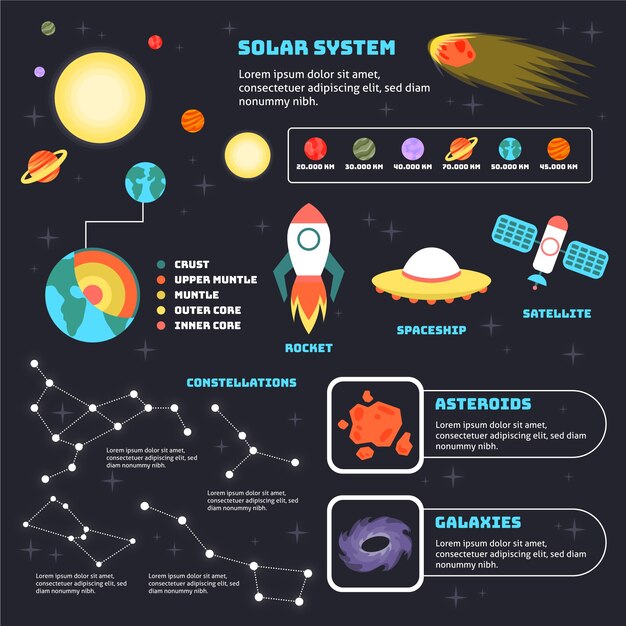Solar System Facts for Kids

The solar system is made up of eight planets and countless other celestial bodies.
Our sun is the star at the center of the solar system, providing light and heat to all the other planets.
The closest planet to the sun is Mercury, which is also the smallest planet in the solar system.
Venus is known as Earth’s sister planet because it is similar in size and composition.
Earth is the only planet in the solar system known to support life.
Mars is often called the red planet because of its reddish appearance.
Jupiter is the largest planet in the solar system and has the most moons.
Saturn is famous for its beautiful rings made up of ice and rocks.
Uranus is tilted on its side, making it unique among the planets.
Neptune is the farthest known planet from the sun, and its blue color comes from the methane in its atmosphere.
Pluto used to be considered the ninth planet but was reclassified as a dwarf planet in 2006.
The solar system is over 4.6 billion years old.
The Voyager 1 spacecraft is the farthest man-made object from Earth and is still sending data about our solar system.
A year on Mercury is equivalent to only 88 Earth days, while a year on Neptune is equivalent to 165 Earth years.
The solar system is located in the Milky Way galaxy, which is just one of billions of galaxies in the universe.
The asteroid belt, located between Mars and Jupiter, is made up of millions of rocky objects.
Solar System Facts for Kids part 2
The largest volcano in the solar system can be found on Mars—Olympus Mons.
The gas giant planets—Jupiter and Saturn—are composed mostly of hydrogen and helium.
A day on Venus is longer than its year because it takes Venus 225 Earth days to complete one rotation on its axis.
Halley’s Comet visits the inner solar system approximately every 76 years.
The solar system is constantly in motion, with all the planets orbiting the sun at different speeds.
The largest moon in the solar system is Ganymede, which orbits Jupiter.
The solar system is home to many powerful storms, such as Jupiter’s Great Red Spot and Saturn’s hexagonal storm.
The surface of Venus is covered in thick clouds, making it the hottest planet in the solar system.
The International Space Station orbits the Earth, but it is not part of the solar system.
The solar system also contains several dwarf planets, such as Eris, Haumea, and Makemake.
It would take over 6,000 years to visit each planet in the solar system for just one day.
The solar system is constantly bombarded by small rocks and dust called meteoroids.
The gravitational pull of the planets affects the orbits of other objects in the solar system.
The sun’s gravity holds the entire solar system together.
The first human-made object to reach interstellar space is Voyager 1, which left the solar system in 20
The solar system is a vast and mysterious place, with many more discoveries waiting to be made.
The temperature on Mercury can reach up to 800 degrees Fahrenheit during the day and drop to -290 degrees Fahrenheit at night.
The surface of Mars is covered in iron oxide, giving it a rusty red color.
Saturn’s rings are made up of countless icy particles, ranging in size from tiny grains to giant boulders.
Jupiter has a strong magnetic field, which creates beautiful auroras near its poles.
The largest moon of Saturn, Titan, has a thick atmosphere and lakes of liquid methane.
The solar system formed from a giant cloud of gas and dust called the solar nebula.
The speed of light is the fastest thing in the universe, traveling at about 186,282 miles per second.
The solar system is a delicate balance of gravity, nuclear fusion, and cosmic forces.
Scientists believe that there may be other solar systems and planets beyond our own, waiting to be discovered.
The cooler outer planets, such as Uranus and Neptune, are often called ice giants because they contain large amounts of water, ammonia, and methane.
Exoplanets are planets that orbit stars outside our solar system, and there are thousands of them discovered so far.
The Hubble Space Telescope has provided us with stunning images and insights about our solar system and the universe.
Exploring the solar system and understanding its many wonders can inspire us to dream big and explore the unknown.

